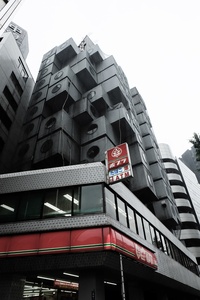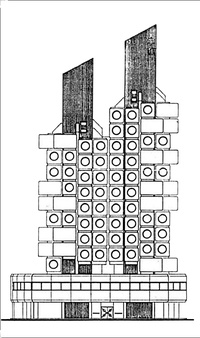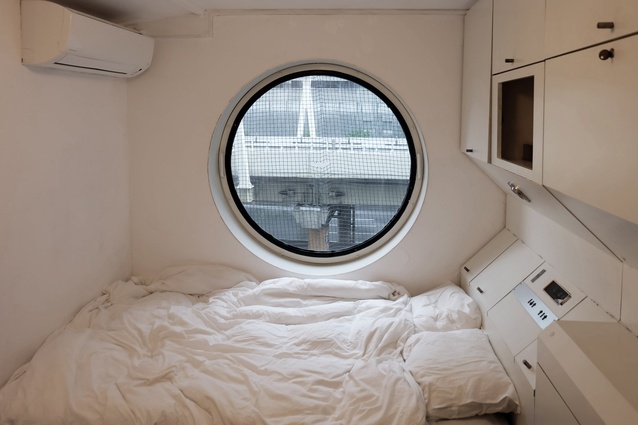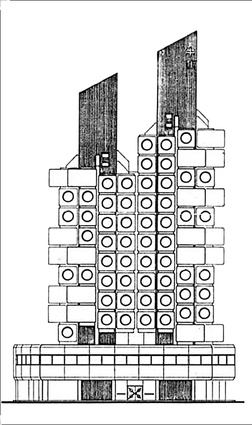The Warren Trust Awards for Architectural Writing 2015 #2
A new essay-writing competition, organised by the NZIA, invited architecture practitioners, tertiary students, members of the public and secondary school students to write about a favourite building or urban space.
Here, we present Wellington architecture graduate Stuart Taylor's essay, which won Highly Commended in the Open category.
Slow Metabolism
Commodity, firmness, delight. So go Vitruvius’ commonly quoted standards for understanding and evaluating a work of architecture. From Palladian palaces to the contemporary Koolhausian house, those three qualities are the ubiquitous and unerring indicators of good architecture. From time to time one term or another might be substituted out for a trendier synonym, but the equation remains as robust as ever. Meet these criteria and you will have yourself an architecture; miss one, and you won’t.
But can it really be that reductively simple to distinguish the good from the bad from the ugly? Call me blasphemous, but I have to disagree. Otherwise, measured against the ancient axioms, one of my favourite buildings is positively a dunger.
On a recent trip to Japan, I found myself in the unsociable hours of the morning staring out across a suspended concrete walkway, eleven stories up, in the midst of a torrential downpour. Grinning like an idiot, and not wholly because of Japanese beer, I was on top of the world. The bridge connected the two towers of a unique example of post-war poptimist architecture – the Nakagin capsule tower, a gloriously eccentric conglomeration of vertically stacked cubic micro-apartments, resembling a low-resolution space station. A building that, due to its failings against the abovementioned criteria, is now dilapidated, practically vacant, and unnervingly close to demolition.

A few years earlier (in similar weather) I had been eleven stories below, on an elevated walkway capturing jaunty and angular student photographs of the tower’s exterior. The building was notoriously difficult to access thanks to privacy concerns arising from behaviour such as mine, and was protected by an over-zealous security guard who could bark “no photo” and “get out” in at least ten languages. I left excited but unsatisfied.
In the intervening years, the democratic wonders of Airbnb had upgraded my aspirations and I was now giddily drinking in a building that has fascinated me since my first year at architecture school when its image flashed across the screen in an otherwise wretchedly dull architectural history lecture.
In 1972 the young Japanese architect Kisho Kurokawa completed an exceptionally ambitious residential tower in the affluent Tokyo district of Shimbashi. Kurokawa was a founding member of the radical Metabolist movement which had sought to re-cast the built environment as a living, dynamic and ever-changing entity. Having been approached by a real estate magnate who had seen his work at the 1970 Osaka Expo, Kurokawa set about designing the scheme that would become one of the only built examples of the Metabolists’ work. He presented a collection of cantilevering modular capsules, efficiently planned and interchangeable, that suggested a solution to the shortage of space in the city and to the rapid and cyclical nature of technological growth, which provided a means to respond to context in a novel and dynamic way.
Originally intended as an inner-city crash pad for the Japanese salary-man (who had more permanent lodgings in the vast and distant suburbs), the building realised a vision of the space-aged future. Consisting of two concrete circulation towers from which 140 rectangular capsules cantilever in a rigidly randomised pattern, the building has the outward appearance of a giant jenga set. Futuristic, state-of-the-art, striking and dynamic, the apartments were quickly snapped up by enthusiastic would-be residents excited at the prospect of owning an ultramodern unit that would be upgraded, updated and upcycled every generation. In line with the Metabolist narrative of growth and renewal, each capsule would be replaced every twenty-five years to ensure its hi-tech trappings never fell too far toward obsolescence.
What the residents got instead was a time-capsule.
A prohibitively expensive refurbishment process, sky-rocketing land-values and a general lack of basic maintenance have pushed the Nakagin Capsule Tower to the precipice of demolition. Now, the building appears like a dilapidated, crumbling and tired fragment from a mid-twentieth-century imagining of what the future might look like. From the outside the large, dark circular portholes (one to each capsule) lack any sense of habitation, or are so crammed with discarded junk that the case for commodity (on the grounds of the building being functional) is a tough proposition. The smog-streaked elevations, weeping steel connections and sagging, asbestos-addled insulation suggest firmness might be out of the question, too. As for the elusive delight – although I was darting around like a kid in a candy shop, I felt I would be hard pressed to make the case that this tired anachronism is anything near to beautiful.
And yet… While the tower may not pay heed to more traditional architectural yardsticks, and despite its sorry condition, there exists the intangible sense that this building is really very special. Under the hi-tech tangles of electric spaghetti and the dank, mouldy façade is a smart piece of design that, but for the cruel imperatives of bottom-line economic drivers and an outmoded aesthetic could well have provided an alternative vision for the twenty-first century city.
The design is audacious. Deceptively simple, the capsules, in their scale, proportions and ordering, demand a clever working of overlapping domestic rituals. Slightly smaller than a twenty-foot shipping container, the interior includes a bathroom barely larger than an aircraft loo. Along one side a shallow cabinetry wall stretches the length of the capsule, containing day-to-day possessions as well as a rather dinky series of fold up, down and sideways hatches and a stunningly obsolete reel-to-reel tapedeck. A round porthole window dominates the remainder of the space, below which is the bed, the only soft surface in the space. The almost ascetic result, while stark, projects that satisfyingly Japanese simplicity that masks the tortuously complex dance of concession and compromise required to make a condensed living space functional. For all the vogue of the tiny-house movement, the Nakagin is a master-class.

To me the most attractive feature of the tower lies in its temporality. The transitory nature of the occupants, or ‘homo-movens’ (as Kurokawa dubbed them), the cycles for the replacement and re-configuration of the capsules, and the terminal status the tower currently holds project an almost biological quality to the observer. The building’s growth, decay and impending death transgress against the core quality of firmness, or durability, and in doing so suggest a human sense. Its ‘for-a-limited-time-only’ condition, brought on by the threat of demolition, amplifies the tower’s appeal and experience, as those lucky enough to ‘see it in the flesh’ are made to observe and appreciate it as a fragile and fleeting moment in the life of a larger built environment.
Oddly, the tower’s demolition is perfectly natural, in the Metabolist sense that all buildings are subject to decay and eventual death. That is perhaps precisely why the Nakagin is so compelling. The controversy surrounding its impending demise imbues the structure with an intangible energy – a great gravitational pull. The suspended but imminent death sentence generates complicated emotions of longing, regret, and excitement. To visit and experience a space before it is irrevocably committed to the annals of built history is motivation to better understand it.
Like many celebrated buildings (that coincidentally also fail the standard Vitruvian classification), the capsule tower attains its significance through the realisation of a far-reaching ideal. The tower stands as a reminder of directions not followed, and the potential of radically different environments generated by contrasting values and agendas. At the ripe age of forty-three, and despite outlasting many other local buildings, the Nagakin tower is too young to be considered a candidate for a heritage listing that would ensure its survival.
I admire the Nagakin Capsule Tower precisely because it fails to tick the empirical boxes that would enable a more tangible reading of what makes a building good or bad architecture. It resists easy categorisation and keeps alive that magical, unknown quality that we constantly and hopelessly strive for.
Solid, useful, beautiful? Hardly. Crumbling, obsolete, ugly? Absolutely. And a bloody good building to boot.
ArchitectureNow will feature a selection of winning and highly commended essays in the following weeks. For Tessa Forde’s essay, which won the Open category award, see here.












